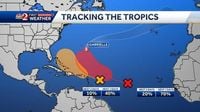Hurricane Gabrielle has rapidly intensified into a major hurricane, churning over the open waters of the central Atlantic and serving as a stark reminder that the 2025 hurricane season is far from over. As of Monday morning, September 22, 2025, Gabrielle was located approximately 195 miles southeast of Bermuda, packing sustained winds of 120 mph and moving north-northwest at 10 mph, according to the National Hurricane Center (NHC) and AccuWeather. The storm’s minimum central pressure was measured at 957 mb, a hallmark of its formidable strength.
For residents along the U.S. East Coast and in Bermuda, the news brings both relief and caution. Though Gabrielle is not expected to make landfall in the United States, its presence will be felt through life-threatening surf and dangerous rip currents stretching from North Carolina northward and even reaching Atlantic Canada. "Since Gabrielle has reached major hurricane intensity east of Bermuda, rough surf and rip currents could be significant and dangerous for the Atlantic beaches early this week," AccuWeather Lead Hurricane Expert Alex DaSilva warned, as reported by AccuWeather.
Gabrielle’s journey to major hurricane status wasn’t straightforward. The storm struggled to survive late last week, hampered by dry air and wind shear. But by Friday and Saturday, thunderstorms became more intense on its eastern side, and wind speeds steadily increased. By Sunday afternoon, Gabrielle was officially classified as a hurricane, and by Monday, it had reached Category 3 on the Saffir-Simpson Hurricane Wind Scale—making it a major hurricane.
The hurricane’s intensification was aided by a zone of low wind shear and an influx of moist air, creating ideal conditions for strengthening. Forecasters with the NHC and AccuWeather anticipate that Gabrielle could reach Category 4 status, with winds between 130 and 156 mph, before cooler waters and increased wind shear begin to sap its strength later in the week. "A weakness in the Bermuda high and steering winds will help turn Gabrielle to the north and keep the storm well away from the United States East Coast," DaSilva explained, emphasizing that direct impacts to the U.S. mainland are not expected.
Still, the storm’s power is nothing to take lightly. The stronger Gabrielle becomes, the larger the waves that will reach U.S. beaches. Swells generated by Gabrielle are already reaching the East Coast, with hazardous surf and rip currents expected to persist through the early part of the week. These conditions are particularly dangerous for swimmers and surfers, prompting warnings from meteorologists and local authorities alike. The main concerns for Bermuda will be rough seas and dangerous surf due to the storm’s close proximity, but no coastal watches or warnings were in effect as of Monday morning.
As Gabrielle moves northward, it is forecast to pass east of Bermuda on Monday night before a turn toward the northeast or east-northeast on Tuesday. The NHC expects some further intensification on Monday, followed by gradual weakening beginning Wednesday as the hurricane encounters less favorable conditions. Hurricane-force winds extend outward up to 30 miles from the center, and tropical-storm-force winds reach 140 miles, making Gabrielle a sizable and potent system.
While Gabrielle commands attention, it is not the only system on the radar. Meteorologists are closely monitoring two additional tropical waves in the Atlantic basin for potential development. The first, a tropical wave in the central tropical Atlantic, is producing limited showers and thunderstorms well to the west-southwest of the Cabo Verde Islands. Although dry air is currently limiting its development, environmental conditions are expected to become more favorable by mid to late week. The NHC gives this system a 20% chance of development over the next 48 hours and a 70% chance over the coming week, with a possible tropical depression forming as it moves west-northwestward across the Atlantic.
The second disturbance is a tropical wave located well to the east of the Lesser Antilles, producing disorganized showers and thunderstorms. As it moves quickly westward at 15 to 20 mph, environmental conditions appear only marginally conducive for slow development. By the latter part of the week, however, the system is expected to slow down and turn more northwestward, potentially increasing its development chances. The NHC currently assigns a 10% chance of development over the next 48 hours and a 40% chance over the next week. Regardless of development, gusty winds and showers are forecast for the Leeward Islands late Monday night and Tuesday.
The 2025 Atlantic hurricane season, which runs from June 1 through November 30, has been relatively quiet so far, especially for North Carolina and the broader U.S. East Coast. However, officials warn that activity is likely to ramp up as suppressing factors like dry air and wind shear fade. The peak of the season typically falls around September 10, with the most active months being August, September, and October. As FOX 35 Storm Team Meteorologist Brooks Garner noted, "The next three names on the list are Humberto, Imelda, and Jerry," highlighting that the season is far from over.
North Carolina, in particular, remains on alert. According to researchers at Colorado State University, the state has one of the highest odds of experiencing hurricane or named storm impacts this season—second only to Florida. Although no storms are currently forecast to directly impact North Carolina, the state’s history with hurricanes and the unpredictable nature of tropical systems mean residents should not become complacent. NOAA urges everyone in hurricane-prone areas to prepare now, emphasizing the importance of disaster supplies, evacuation plans, and insurance checkups. "Get your disaster supplies while the shelves are still stocked, and get that insurance checkup early, as flood insurance requires a 30-day waiting period," NOAA recommends.
For those in Bermuda, vigilance is also advised. While the most likely scenario keeps Gabrielle’s center east of the island, even a glancing blow could bring hazardous surf and rough seas. The NHC and AccuWeather both stress the importance of monitoring official updates and being prepared for rapidly changing conditions.
In the broader context, the Atlantic hurricane basin remains a hotbed of activity as September draws to a close. The development of multiple tropical waves—each with varying chances of intensification—underscores the need for ongoing vigilance. As DaSilva put it, "We will monitor these areas closely for any signs of tropical activity, due to the risk of rapid strengthening."
With Hurricane Gabrielle now a major force over the Atlantic and two more systems on the horizon, the 2025 hurricane season is entering a critical phase. The coming weeks will test the preparedness of coastal communities from Bermuda to the Carolinas and beyond, as meteorologists and residents alike keep a watchful eye on the tropics.




